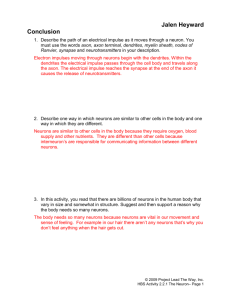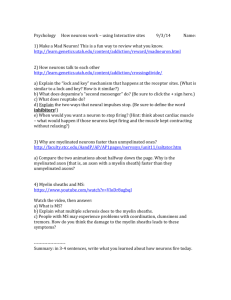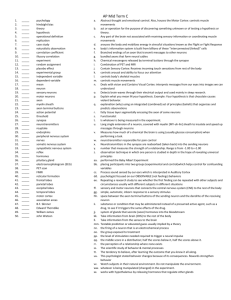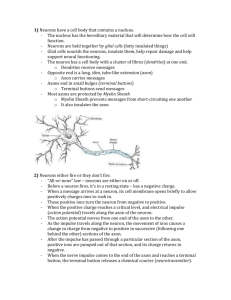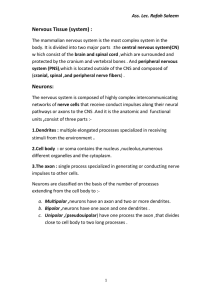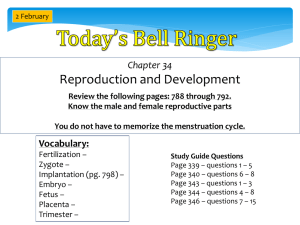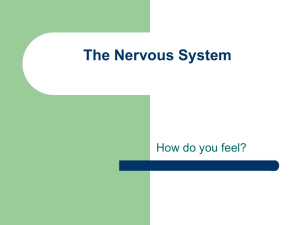What a Neuron Looks Like
advertisement
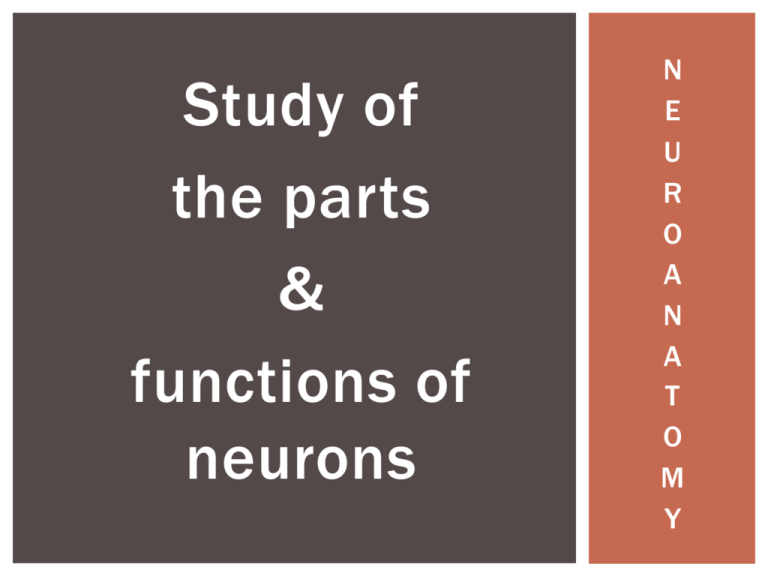
Study of the parts & functions of neurons N E U R O A N A T O M Y WHAT A NEURON LOOKS LIKE 3 MAIN TASKS OF NEURONS Cells are specialized to… 1.) Receive information from the neurons that feed it. 2.) Process the information 3.) Pass on information to the next neuron. 3 TYPES OF NEURONS: SENSORY NEURONS Carries sensory information toward the brain & spine. What are your senses? 3 TYPES OF NEURONS: MOTOR NEURONS Transport messages away from the brain to the muscles, organs and glands. 3 TYPES OF NEURONS INTERNEURONS aka the middle man Sensory and motor neurons do not communicate directly with each other. Found in the brain and spine REFLEXES EVEN A HEADLESS WARM BODY COULD DO THAT! parts & functions PARTS & FUNCTION: DENDRITES Receives messages from incoming terminal branches of other cells Passes message to cell body PARTS & FUNCTION: CELL BODY Contains the cell’s nucleus (life-support) Assesses all messages & passes on info at the appropriate time PARTS & FUNCTION: AXON Cell body sends the message down the axon Moves info from cell body to terminal branch This is a one way street Brain; the axons are very short Leg; they can reach 3 feet long PARTS OF THE AXON: MYELIN SHEATH Layer of fatty tissue that insulates the axon and speeds up the impulse and protects the message Covering on your headphones If myelin sheath deteriorates: Communication to muscles slows leading to eventual loss of muscle control aka, Multiple Sclerosis (MS) PARTS & FUNCTION: TERMINAL BRANCH Forms junction with next cell by releasing the message into the synapse How neurons communicate!!!! ELECTROCHEMICAL COMMUNICATION Information travels along the axon electrochemically (chemical change causes an electric signal) What are the messages? Neurotransmitters & hormones HOW THE CELL BODY KNOWS WHEN TO SEND AN ACTION POTENTIAL Dendrites send two types of messages to the cell body If ‘excitatory’ messages outnumber ‘inhibitory’ messages, the cell reached absolute threshold Now the cell body releases an impulse that sends the message down the axon The impulse and the movement of the message is called ACTION POTENTIAL HOW THE MESSAGE GETS ‘THERE’…WHERE? Once the cell body releases an Action Potential, the message gets carried down the axon and ends at the terminal branches PARTS OF ACTION POTENTIAL While the neuron is waiting to receive a message, its called ‘resting potential’ The cell body processes the message and if absolute threshold is reached, the impulse is fired. Once the cell body fires an impulse, there is no going back! ALL OR NOTHING PRINCIPLE It fires in the same direction every time (dendrites to terminal branches) Once the cell body fires, it needs time to reset; refractory period Just because the signal is stronger doesn’t mean the message goes faster! How do we tell the difference between a tap and a slap? WHAT HAPPENS AT THE TERMINAL BRANCH? When an action potential reaches a terminal branch, it releases the message into the synapse These neurotransmitters stimulate the dendrites on the next cell; the whole process starts over again MR. N GOES TO THE BATHROOM

